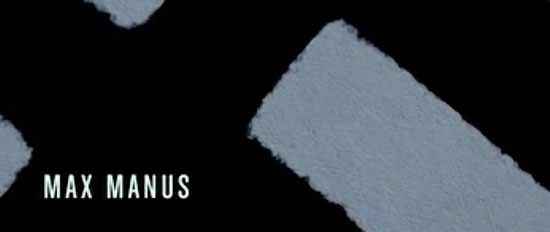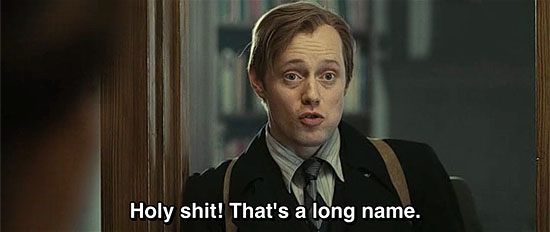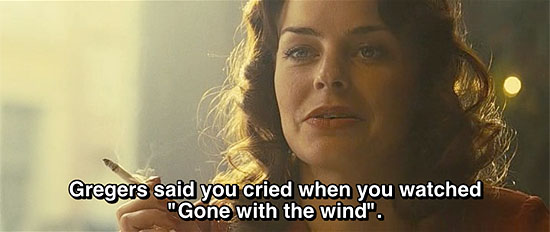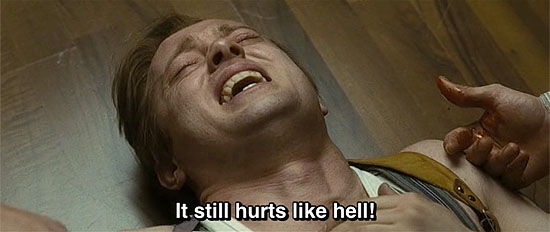
 BUY FROM AMAZON: CLICK HERE!
BUY FROM AMAZON: CLICK HERE!
MSRP $24.95
RATED NR
STUDIO Music Box Films Home Entertainment
RUNNING TIME 113 Minutes
SPECIAL FEATURES
• Max Manus: Film and Reality
• Trailer
The Pitch
The story of the man who owned the biggest set of brass balls in all of Norway.
The Humans
Aksel Hennie, Agnes Kittelsen, Ken Duken, Joachim Rønning, Espen Sandberg
The Nutshell
Max Manus is a Norwegian freedom fighter involved in liberating his country from Nazi occupation. His ability to carry out sabotage attacks on the Germans with pinpoint precision earns him a reputation as one of Norway’s elite. Despite his numerous triumphs on the battlefront, Manus struggles to come to terms with the loss of his comrade’s lives and the futility of war. Based on true events, this film’s moving storyline and stunning visual brings to life this epic chapter in World War II history.

The process of naming newly discovered species of bacteria can be an arduous one.
The Lowdown
I’ve been on a Scandinavian kick lately. My last review was a Swedish book, preceded by a Norwegian film. Now I’m doing another Norwegian film. Perhaps if I smoke an Amsterdam-size joint whilst eating a danish and drinking Finnish sahti, I’ll turn into a viking. Of course that won’t happen, but that won’t stop me from trying. The point is this: I like the stuff that’s been coming out of Scandinavia over the past few years. Norwegian directors Joachim Rønning and Espen Sandberg had a strong release last year with Kon-Tiki, which became one of my favorite foreign language films of 2012. It’s a high seas adventure laden with terrific CGI animals, it’s based on a fascinating true story, and I think it beats the fucking pants off Ang Lee’s Life of Pi.
Anyway, that’s how I ended up with these two Norwegian filmmakers on my cinematic radar. But I wasn’t the only with my eye on them. If you’re remotely interested in Disney’s Pirates of the Caribbean franchise, you might have heard that the fifth entry is now set for 2016, and is tentatively subtitled Dead Men Tell No Tales (other potential names included Yo Ho Ho, Very Bad Eggs, Piratey Piratey Piratey, and Sparrow Sings a Swan Song). At the helm of this new film are none other than Rønning and Sandberg, and I can’t deny that I’m intrigued. They’re very different filmmakers than Gore Verbinksi (whom I admire) or Rob Marshall (whom I also admire, but seems more suited to direct The Pirates of Penzance), but what Kon-Tiki proves is that they know how to handle epic, effects-heavy, period adventure films.

A. Turkish Pretzel is the best children’s author pseudonym since Lemony Snicket.
But before Kon-Tiki came to be, Rønning and Sandberg made Max Manus: Man of War. Like Kon-Tiki, it’s a highly dramatized version of a true story. I am admittedly ignorant when it comes to Norwegian history, but I am curious, and found myself immediately hooked by the concept alone. Max has a great story, and it is well adapted by young screenwriter Thomas Nordseth-Tiller, who tragically passed away of cancer shortly after the film’s release. While I can’t speak to the screenplay’s historical accuracy, I think can speak to the quality of the writing. It’s great stuff, packed with zippy dialogue, and it’s brought vividly to life through fastidious direction and stellar performances.
After the opening credits, we are dropped into a snowy shootout on the Finland-Soviet border, where Max is fighting against the Soviets on the front lines of the Winter War. The scene is violent and gritty, brilliantly establishing a source of Max’s future anxieties. We repeatedly flash back to the shootout throughout the film, getting a bit more information each time. The film then races off to Nazi-occupied Norway, efficiently establishing Max’s role in the Norwegian resistance. The whole first act is pure dynamite; a slickly-shot war thriller with ample humor and romance.

SO FUCKING WHAT IF I DID?!
The second and third acts of the film are just as good as the first, but there is an obvious and jarring shift in tone. The film suddenly becomes a grim, tense tale of sabotage. Max’s closest friends start dying at the hands of the Nazis, and every death is a kick in the nuts. Max begins to drink heavily. He can’t be with the woman he loves. All of the fun in the first act was a setup for some truly gut-wrenching scenes, many of which are thanks to the film’s exceptional villain. Ken Duken plays Gestapo officer Siegfried Fehmer as a stunningly handsome yet slimy reptile. Like Aksel Hennie’s Max, Siegfried is quite charming, but with Siegfried there’s always a steely glint of ulterior motive in his eyes.
If you can get past the tonal shift, there are still great things to see. Rønning and Sandberg love to keep the camera moving, with delicate control. There’s no egregious “shaky-cam” in the film, but there is some fantastic steadicam work that really pulls the viewer in, giving the film a sense of swift priority. The scenes where Max and his comrades attach limpet mines to the sides of German warships are standout sequences, combining the energy of a great heist film with the quiet tension of DePalma’s Mission Impossible.

My feelings whenever somebody mentions M. Night Shyamalan’s Lady in the Water.
Aside from the film’s big tonal shift, the only other letdown in the film is that it doesn’t go for the huge, explosive, cathartic ending you think it should. The aftermath, rather than the action, is more important to the narrative. If anything, the film’s necessity for historical accuracy prevents it from achieving the rollicking adventure promised in the first act. The film becomes a hard-hitting war drama, more interested in character study than action or scale. Regardless of its few shortcomings, Max Manus is a class act from start to finish, and one of the best World War II films of the past decade.
The Package
The presentation on this disc is stellar, with a razor-sharp transfer and rich audio. The color palette of the film favors blues and grays, but never looks muddy or washed out. The splashes of warmth that appear in the film are just as gorgeous. The audio is a 5.1 DTS-HD Master Audio track, and it sounds fantastic. The scenes during the Winter War sound appropriately explosive, but the quieter scenes in restaurants and offices are packed with much needed ambience.
In the extras department, the disc is a bit light. There’s the customary trailer, of course, but there’s also a forty-five-minute documentary. Max Manus: Film and Reality is an informative (but not comprehensive) look at Manus’ life and the process of adapting that life for the screen. It’s a little dry at first, like something you might see on The History Channel, but if you liked the film, the documentary is well worth a look. It features a great deal of interview and stock footage, but there is some great footage of the real Manus describing how he jumped out of a second story window to escape the Gestapo. This guy had surely had some brass balls, and this film is a fitting tribute to his legacy.
Rating: 




Out of a Possible 5 Stars